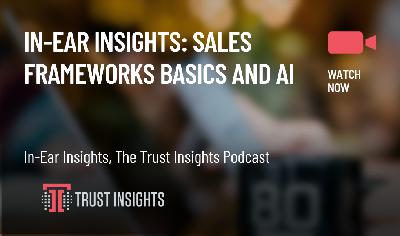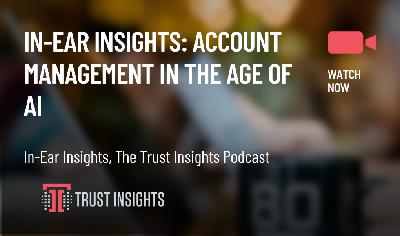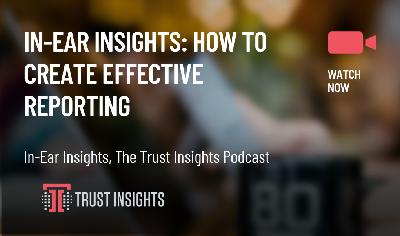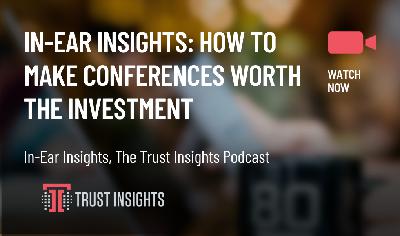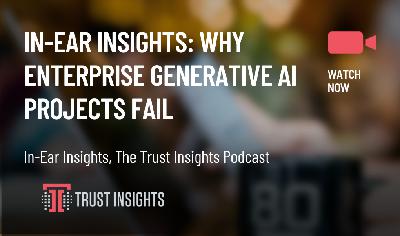In-Ear Insights: Getting Real Value from Generative AI
Description
In this episode of In-Ear Insights, the Trust Insights podcast, Katie and Chris discuss scaling Generative AI past basic prompting and achieving real business value.
You will learn the strategic framework necessary to move beyond simple, one-off interactions with large language models. You will discover why focusing on your data quality, or “ingredients,” is more critical than finding the ultimate prompt formula. You will understand how connecting AI to your core business systems using agent technology will unlock massive time savings and efficiencies. You will gain insight into defining clear, measurable goals for AI projects using effective user stories and the 5P methodology. Stop treating AI like a chatbot intern and start building automated value—watch now to find out how!
Watch the video here:
Can’t see anything? Watch it on YouTube here.
Listen to the audio here:
https://traffic.libsyn.com/inearinsights/tipodcast-getting-real-value-from-generative-ai.mp3
- Need help with your company’s data and analytics? Let us know!
- Join our free Slack group for marketers interested in analytics!
[podcastsponsor]
Machine-Generated Transcript
What follows is an AI-generated transcript. The transcript may contain errors and is not a substitute for listening to the episode.
Christopher S. Penn – 00:00
In this week’s *In-Ear Insights*. Another week, another gazillion posts on LinkedIn and various social networks about the ultimate ChatGPT prompt. OpenAI, of course, published its Prompt Blocks library of hundreds of mediocre prompts that are particularly unhelpful.
And what we’re seeing in the AI industry is this: A lot of people are stuck and focused on how do I prompt ChatGPT to do this, that, or the other thing, when in reality that’s not where the value is.
Today, let’s talk about where the value of generative AI actually is, because a lot of people still seem very stuck on the 101 basics. And there’s nothing wrong with that—that is totally great—but what comes after it?
Christopher S. Penn – 00:47
So, Katie, from your perspective as someone who is not the propeller head in this company and is very representative of the business user who wants real results from this stuff and not just shiny objects, what do you see in the Generative AI space right now? And more important, what do you see it’s missing?
Katie Robbert – 01:14
I see it’s missing any kind of strategy, to be quite honest. The way that people are using generative AI—and this is a broad stroke, it’s a generalization—is still very one-off. Let me go to ChatGPT to summarize these meeting notes. Let me go to Gemini to outline a blog post. There is nothing wrong with that, but it’s not a strategy; it’s one more tool in your stack. And so the big thing that I see missing is, what are we doing with this long term?
Katie Robbert – 01:53
Where does it fit into the overall workflow and how is it actually becoming part of the team? How is it becoming integrated into the organization? So, people who are saying, “Well, we’re sitting down for our 2026 planning, we need to figure out where AI fits in,” I think you’re already setting yourself up for failure because you’re leading with AI needs to fit in somewhere versus you need to lead with what do we need to do in 2026, period?
Chris has brought up the 5P Framework, which is 100% where I’m going to recommend you start. Start with the purpose. So, what are your goals? What are the questions you’re trying to answer? How are you trying to grow and scale? And what are the KPIs that you want to be thinking about in 2026?
Katie Robbert – 02:46
Notice I didn’t say with AI. Leave AI out of it for now. For now, we’ll get to it. So what are the things that you’re trying to do? What is the purpose of having a business in 2026? What are the things you’re trying to achieve?
Then you move on to people. Well, who’s involved? It’s the team, it’s the executives, it’s the customers. Don’t forget about the customers because they’re kind of the reason you have a business in the first place. And figure out what all of those individuals bring to the table. How are they going to help you with your purpose and then the process? How are we going to do these things? So, in order to scale the business by 10x, we need to bring in 20x revenue.
Katie Robbert – 03:33
In order to bring in 20x revenue, we need to bring in 30x visits to the website. And you start to go down that road. That’s sort of your process. And guess what? We haven’t even talked about AI yet, because it doesn’t matter at the moment. You need to get those pieces figured out first.
If we need to bring in 30x the visits to the website that we were getting in the previous year, how do we do that? What are we doing today? What do we need to do tomorrow? Okay, we need to create content, we need to disseminate it, we need to measure it, we need to do this. Oh, maybe now we can think about platforms. That’s where you can start to figure out where in this does AI fit?
Katie Robbert – 04:12
And I think that’s the piece that’s missing: people are jumping to AI first and not why the heck are we doing this. So that is my long-winded rant. Chris, I would love to hear your perspective.
Christopher S. Penn – 04:23
Perspective specific to AI. Where people are getting tripped up is in a couple different areas. The biggest at the basic level is a misunderstanding of prompting. And we’re going to be talking about this. You’ll hear a lot about this fall as we are on the conference circuit.
Prompting is like a recipe. So you have a recipe for baking beef Wellington, what have you. The recipe is not the most important part of the process. It’s important. Winging it, particularly for complex dishes, is not a good idea unless you’ve done it a million times before. The most important part is things like the ingredients. You can have the best recipe in the world; if you have no ingredients, you ain’t eating. That’s pretty obvious.
Christopher S. Penn – 05:15
And yet so many people are so focused on, “Oh, I’ve got to have the perfect prompt”—no, you don’t. You need to have good ingredients to get value.
So, let’s say you’re doing 2026 strategic planning and you go to the AI to say, “I need to work on my strategic plan for 2026.” They will understand generally what that means because most models are reasoning models now. But if you provide no data about who you are, what you do, how you’ve done it, your results before, who your competitors are, who your customers are, all the 10 things that you need to do strategic planning like your budget, who’s involved, the Five Ps—basically AI won’t be able to help you any better than you will or that your team will. It’s a waste of time.
Christopher S. Penn – 06:00
For immediate value unlocks for AI, it starts with the right ingredients, with the right recipe, and your skills. So that should sound an awful lot like people, process, and platform.
I call it Generative AI 102. If 101 is, “How do I prompt?” 102 is, “What ingredients need to go with my prompt to get value out of them?”
But then 201 is—and this is exactly what you started off with, Katie—one-off interactions with ChatGPT don’t scale. They don’t deliver value because you, the human, are still typing away like a little monkey at the keyboard. If you want value from AI, part of its value comes from saving time, saving money, and making money. Saving time means scale—doing things at scale—which means you need to connect your AI to other systems.
Christopher S. Penn – 06:59
You need to plug it into your email, into your CRM, into your DSP. Name the technology platform of your choice. If you are still just copy-pasting in and out of ChatGPT, you’re not going to get the value you want because you are the bottleneck.
Katie Robbert – 07:16
I think that this extends to the conversations around agentic AI. Again, are you thinking about it as a one-off or are you thinking about it as a true integration into your workflow? Okay, so I don’t want to have to summarize meeting notes anymore. So let me spend a week building an agent that’s going to do that for me. Okay, great.
So now you have an agent that summarizes your meeting notes and doesn’t do anything else. So now you have to, okay, what else do I want it to do? And you start frankensteining together all of these one-off tasks until you have 100 agents to do 100 things versus maybe one really solid workflow that could have done a lot of things and have less failure points.
Katie Robbert – 08:00
That’s really what we’re talking about. When you’re short-sighted in thinking about where generative AI fits in, you introduce even more failure points in your business—your operations, your process, your marketing, whatever it is. Because you’re just saying, “Okay, I’m going to use ChatGPT for this, and I’m going to use Gemini for this, and I’m going to use Claude for this, and I’m use Google Colab for this.”
Then it’s just kind of all over the place. Really, what you w


